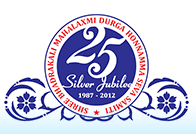
On first Saturday of every month, Monthly pooja is conducted at the registered office of the Samiti with Darshan seva. The pooja is preceded by reading of Durgashaptashati parayan by Vedic followed by Kumkumarchana seva.
On ninth day of Jyestha month, the Samiti celebrates Murthy Pratishvardhanti day. This is to celebrate the anniversary of installation of Panchloha (alloy of 5 metals) idol of Goddess Bhadrakali Mahalaxmi Durga Honnamma at the Samitiís registered office in 2010. The celebrations begin with Shiyale Abhishekha (Tender Coconut bath to the deity). The current year 2012 being Silver Jubilee celebrations year, Kalash Abhishekha (holy water in copper utensils) was also performed. This is followed by various offerings to the Goddess by way of Neerikshana & Pattakanike and Madhyana Pooja with Darshan Seva to the deity. The Samiti distributes free notebooks and stationery to school children on the occasion to begin the new academic year with blessings of the Goddess. In the evening, Asthavadana Seva (vedic hymns followed intermittently by eight different types of musical instruments) is performed during Pushpa (flower) Pooja .
On twenty seventh day of Ashadh month, the Samiti celebrates erstwhile Pratishtavardhanti day (i.e anniversary of Samitiís establishment in 1987 with image of the deity at the Samitiís registered office). The image was replaced by Panchloha idol in 2010 which anniversary is being celebrated as Murthy Pratishtavardhanti day. To commemorate the erstwhile Pratishtavardhanti, a special pooja called Vishesha Kumkumarchana is performed in the evening by married women by offering kumkum (vermillion) and flowers to decorated oil lamps amidst chanting of vedic mantras by priests.
At midnight of eighth day of Shravan month,
pooja is performed to celebrate the birth
anniversary of Lord Krishna with chanting of
verses in praise of Lord Krishna.
On fourth day of Bhadrapad month, pooja is
performed to celebrate festival of Lord Ganesh (Ganesh
Chaturthi).
The most significant annual event of the Samiti
is GSB Sarvajanik Navaratriutsav Celebrations
during the first to tenth day of Ashwin month.
The celebrations are conducted at a bigger venue
in the vicinity viz. Shree Dandeshwar Mandir
Sabhagruha, Shankar Mandir Compound, Khar Danda.
The first day begins early with morning pooja at
Samitiís registered office and the deities are
brought to the Navaratriutsav venue in a
procession. Before installing the deity at the
venue, pooja is also performed at Shankar Mandir.
The celebrations begin with Ganahoma i.e
offerings to Lord Ganesha through Agni (fire) to
seek his blessings for the successful conduct of
the celebrations. Every day Navachandika Havana
is performed on behalf of devotee which begins
at 8.00 am in the morning and concludes at 1.30
pm in the afternoon. This is an important ritual
which includes chanting of verses from
Durgashaptashati accompanied by various
offerings to Goddess through Agni.
Simultaneously, pooja is performed to Goddess
with Panchamrutha Abhishekha in the morning.
Devotees also offer Tulabhar Seva by offering
coconuts, sugar, rice or any other item equal to
their weight to the Goddess. The Chandika Havana
is followed by Mahapooja in the afternoon with
Darshan seva. In the evening, bhajans (i.e
devotional songs) are sung in praise of Goddess
by bhajan group invited by the Samiti. Also,
Durga Namaskar Seva is performed on behalf of
devotee. This seva involves worshipping an oil
lamp decorated with saree and flower garlands.
Devotees perform 108 pradakshinas (revolutions)
around the decorated oil lamp amidst chanting of
vedic verses by priests. Further, Nav Durga Devi
Ranga Pooja is performed in the evening on
behalf of devotees which involves offering of
several items like coconuts, fruits, etc set on
banana leaves to Goddess. Several cultural
programmes like devotional music compositions by
artists, dramas, bhajan singing/fancy
dress/dance competitions, etc are also organized
in the evening. Each day concludes with Pushpa
pooja with Darshan seva. Special pooja is
conducted on Lalita Panchami (fifth) day of the
celebrations. Further, on Asthami (eighth) day
which is the most auspicious day of the
festival, the Chandika Havana is performed by
the Samiti on behalf of the entire society for
the prosperity and well being of the entire
society. The Mahila Mandal (ladies wing) of the
Samiti organizes Haldi Kumkum, a special event
for married women during one of the days of the
festival. A voluntary blood donation camp is
also organized on one day towards fulfillment of
social obligation to the society. The
celebrations conclude on tenth day in the
afternoon with Vijayadashami pooja and the deity
is taken back to the Samitiís registered office
in a gala procession. Every Navaratriutsav
celebration is followed by a get-together of all
volunteers to celebrate the successful
conclusion of the festival and also exchange
thoughts and feedback for improvements.
The Samiti performs seva on the fifteenth day of
Ashvin month at Shree Durga Honnamma Devi
Moolsthan Temple at Siddhapura (near Kundapura
in Karnataka state) which is attended by some of
the committee members of the Samiti. The Samiti
also participates in Chandika Havana performed
on fifteenth day of Margasheesh month at
Moolsthan temple.
During the entire month of Kartik, Deeparadhana
Seva is performed in the evening on behalf of
devotees by lighting of oil lamps. Ashtavadana
Seva is performed on _____ day on behalf of the
Samiti.
On the fourth day of Maagh month, Ganesh Jayanti
is celebrated commencing with Ganahoma and
Shiyale Abhishekha in the morning followed by
Madhyana pooja in the afternoon and Ranga Pooja
to Lord Ganesh in the evening on behalf of
devotees.



